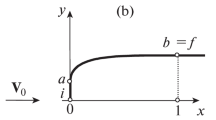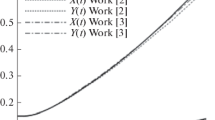Abstract—
The problems of designing the contours of two-dimensional and axisymmetric bodies of minimum wave drag and maximum-thrust nozzles, such that flow past them can contain internal shocks, are considered within the ideal (inviscid and non-heat-conducting) gas model. These shocks may occur in flows past internal breaks in the optimal contours or on intersection of characteristics of the same family proceeding from these breaks. The submerged shocks occurring in the latter case are named internal, if their initial points lie within the domain of determinacy of the flowed-over optimal contour region. Further downstream the domain of determinacy is bounded by the characteristic coming to the end point of this contour. The internal submerged shocks can appear, when the optimal contour includes an interval of an isobaric streamline. The appearance of internal breaks in the optimal contours is possible due to the reflection of the pressure waves induced by them from the bow shock (for body noses) or, as might be expected, from tangential discontinuities (for afterbodies). In the case of supersonic freestreams having a tangential discontinuity the search for optimal two-dimensional afterbodies with an internal concave break flowed-over with an oblique shock is performed using the direct method with the representation of the required contours by the Bernstein—Bézier curves, a genetic algorithm, and a rapid and accurate marching scheme for calculating steady supersonic flows. While the optimal two-dimensional afterbodies with a convex internal break designed earlier using the general method of Lagrange multipliers could be reliably reproduced using the above-mentioned method, the expected optimal configurations with a concave break and an internal shock were not found. Instead, optimal contours with centered compression and expansion waves with the common focus on a tangential discontinuity and an “external” oblique shock proceeding from it were discovered. Then the new “discontinuous shock-free” solutions were constructed in the exact formulation, within the framework of the method of indefinite control contours and the method of characteristics. The solutions are generalized to include the contours of the afterbodies of revolution and supersonic parts of nozzles. In the case of a uniform freestream the flow past optimal afterbodies never includes internal shocks.









Similar content being viewed by others
REFERENCES
A. N. Kraiko, Theoretical Gas Dynamics: Classics and the Present Day (Torus Press, Moscow, 2010) [in Russian].
G. G. Chernyi, “Supersonic flow past a wedge-shaped profile,” Trudy TsIAM No. 197 (1950) [see also Gas Dynamics. Selected Works, Vol. 1, Ed. by A. Kraiko (Fizmatlit, Moscow, 2005), pp. 443–462 [in Russian].
G. G. Chernyi, Introduction to Hypersonic Flow Theory (Academic, New York, 1966).
A. V. Shipilin, “Variational problems of gasdynamics with attached shock waves,” in: Theoretical Studies on Hydrodynamics. Proceedings of the Computer Center of the USSR Academy of Sciences (Moscow, 1970), pp. 54–106 [in Russian].
A. N. Kraiko, Variational Problems of Gas Dynamics (Nauka, Moscow, 1979) [in Russian].
Yu. D. Shmyglevskii, Analytic Investigations in Fluid Dynamics (Editorial URSS, Moscow, 1999) [in Russian].
A. N. Kraiko and D. Ye. Pudovikov, “The construction of the optimal contour of leading edge of a body in a supersonic flow,” J. Appl. Math. Mech. 59 (3), 395–408 (1995).
A. N. Kraiko, D. E. Pudovikov, and G. E. Yakunina, Theory of Near-Optimal Aerodynamic Shapes (Yanus-K, Moscow, 2001) [in Russian].
A. N. Kraiko, A. S. Telyakovskii, and N. I. Tillyayeva, “Profiling the optimal contour of a supersonic nozzle in highly rotational flow,” Comp. Math. Math. Phys. 34 (10), 1251–1263 (1994).
A. N. Kraiko and N. I. Tillyayeva, “Optimal profiling of the supersonic part of a plug nozzle contour,” Fluid Dynamics 35(6), 945-955 (2000).
A. N. Kraiko, K. S. P’yankov, and N. I. Tillyayeva, “Profiling the supersonic part of a plug nozzle with a nonuniform transonic flow,” Fluid Dynamics 37(4), 637–648 (2002).
A. R. Mustaev and N. A. Ostapenko, “Plane contours with maximum thrust in a non-isentropic flow,” J. Physics: Conf. Series 1129 (1), 012026 (2018).
A. R. Mustaev and N. A. Ostapenko, “Shock contours of maximum thrust,” in: Abstracts of the All-Russian School-Seminar “Modern Problems in Aerohydrodynamics,” Sochi, 5–15 September 2019 (Moscow Univ. Press, 2019), p. 79 [in Russian].
L. V. Gogish, “A study of short supersonic nozzles,” Fluid Dynamics 1(2), 122–126 (1966).
A. N. Kraiko, D. A. Mel’nikov, U. G. Pirumov, A. A. Sergeenko, L. E. Sternin, and Yu. D. Shmyglevskii, “Comment on L.V. Gogish’s article “A study of short supersonic nozzles” (MZG [Fluid Dynamics] No. 2, pp. 175–180, 1966), Fluid Dynamics 2 (1), 119 (1967).
A. N. Kraiko and N. I. Tilliaeva, “On constructing the contour of minimum wave drag in an inhomogeneous supersonic flow,” J. Appl. Math. Mech. 37(3), 449–467 (1973).
K. G. Guderley and J. V. Armitage, “General approach to optimum rocket nozzles,” in: Theory of Optimum Aerodynamic Shapes. Ed. by A. Miele (Academic, New York, 1965), pp. 161–183.
A. N. Kraiko, “Variational problems of gas dynamics of nonequilibrium and equilibrium flows,” J. Appl. Math. Mech. 28 (2), 348–360 (1964).
A. N. Kraiko, “On the solution of variational problems of supersonic gas dynamics,” J. Appl. Math. Mech. 30 (2), 381–391 (1966).
K. S. P’yankov and N. I. Tillyaeva, “Multi-objective multidisciplinary design optimization of fan rotor blades on the basis of a genetic algorithm,” Tekhn. Vozd. Flota, No. 3, 58–67 (2010) [in Russian].
A. A. Kraiko, K. S. P’yankov, N. I. Tillyaeva, and M. N. Toporkov, “Optimization of a birotative fan with account for the stress-strain state on the basis of a genetic algorithm,” Tekhn. Vozd. Flota, No. 1, 22–34 (2014) [in Russian].
A. A. Kraiko, K. S. P’yankov, and N. I. Tillyaeva, “Contouring two-sided asymmetric plane maximum-thrust nozzles,” Fluid Dynamics 51 (1), 120–125 (2016).
N. I. Tillyaeva, “Comparison of the efficiencies of spike and combined annular nozzles,” Fluid Dynamics 52 (4), 587–598 (2017).
A. N. Kraiko, I. N. Naumova, and Yu. D. Smyglevskii, “On the construction of bodies of optimum shape in a supersonic stream,” J. Appl. Math. Mech. 28(1), 214–219 (1964).
I. P. Bol’shiyanov, N. N. Zakharov, K. S. P’yankov, and N. I. Tillyaeva, “Optimal axisymmetric noses of bodies in a flow. Calculations and experiments,” Fluid Dynamics 53 (2), 296–304 (2018).
M. Ya. Ivanov, A. N. Kraiko, and N. V. Mikhaylov, “A method of through computation for two- and three-dimensional supersonic flows. I,” Comput. Math. Math. Phys. 12 (2), 196–221 (1972).
S. Godunov, A. Zabrodine, M. Ivanov, A. Kraïko, and G. Prokopov, Résolution Numérique des Problèmes Multidimensionnels de la Dynamique des Gaz (Mir, Moscow, 1979).
V. P. Kolgan, “Application of the principle of minimum values of the derivative to the construction of finite-difference schemes for calculating discontinuous solutions of gas dynamics,” Uch. Zap. TsAGI 3 (6), 68–77 (1972) [in Russian] [see also J. Comput. Phys. 230, 2384–2390 (2011)].
A. V. Rodionov, “Methods of increasing the accuracy in Godunov’s scheme,” Comput. Math. Math. Phys. 27 (6), 164–169 (1987).
. I. Tillyaeva, “Generalization of the modified Godunov scheme on arbitrary irregular grids,” Uch. Zap. TsAGI 17 (2), 18–26 (1986) [see also in Gas Dynamics. Selected works, Vol. 2, Ed. by A. Kraiko, A. Vatazhin, and A. Sekundov (Fizmatlit, Moscow, 2005), pp. 201–210 [in Russian]
Yu. D. Smyglevskii, “Variational problems for supersonic bodies of revolution and nozzles,” J. Appl. Math. Mech. 26 (1), 150–171 (1962).
Yu. D. Shmyglevskii, Certain Variational Problems of Gas Dynamics (Computer Center of the USSR Academy of Sciences, 1963) [in Russian].
A. N. Kraiko, Variational Problems of Supersonic Gas Flow with Arbitrary Thermodynamic Properties (Computer Center of the USSR Academy of Sciences, 1963) [in Russian].
Funding
The study was carried out with the support of the Russian Foundation of Basic Research (projects 19-01-00671 and 20-01-00100).
Author information
Authors and Affiliations
Corresponding authors
Ethics declarations
The Authors declare no potential conflicts of interest with respect to the research, authorship, and/or publication of this article.
Additional information
Translated by M. Lebedev
Rights and permissions
About this article
Cite this article
Kraiko, A.N., P’yankov, K.S., Tillyaeva, N.I. et al. Internal Shocks in Supersonic Flows past the Contours of Optimal Bodies and Nozzles. Fluid Dyn 55, 840–857 (2020). https://doi.org/10.1134/S0015462820060075
Received:
Revised:
Accepted:
Published:
Issue Date:
DOI: https://doi.org/10.1134/S0015462820060075




